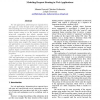Free Online Productivity Tools
i2Speak
i2Symbol
i2OCR
iTex2Img
iWeb2Print
iWeb2Shot
i2Type
iPdf2Split
iPdf2Merge
i2Bopomofo
i2Arabic
i2Style
i2Image
i2PDF
iLatex2Rtf
Sci2ools
WSE
2006
IEEE
2006
IEEE
Modeling Request Routing in Web Applications
For web applications, determining how requests from a web page are routed through server components can be time-consuming and error-prone due to the complex set of rules and mechanisms used in a platform such as J2EE. We define request routing to be the possible sequences of server-side components that handle requests. Many maintenance tasks require the developer to understand the request routing, so this complexity increases maintenance costs. However, viewing this problem at the architecture level provides some insight. The request routing in these web applications is an example of a pipeline architectural pattern: each request is processed by a sequence of components that form a pipeline. Communication between pipeline stages is event-based, which increases flexibility but obscures the pipeline structure because communication is indirect. Our approach for improving the maintainability of J2EE web applications is to provide a model that exposes this architectural information. We use...
| Added | 12 Jun 2010 |
| Updated | 12 Jun 2010 |
| Type | Conference |
| Year | 2006 |
| Where | WSE |
| Authors | Minmin Han, Christine Hofmeister |
Comments (0)

